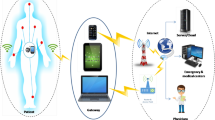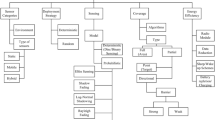Abstract
In wireless sensor networks, trust management schemes are designed to preserve them against misbehavior of malicious sensor nodes. These schemes observe the behavior of nodes, check their conformity to what is expected, compute and assign them trust values, and avoid any interaction with untrustworthy nodes. In this paper, we introduce Adaptive and dual Data-Communication Trust scheme (ADCT) for clustered wireless sensor networks to effectively deal with untrustworthy nodes. Unlike prior works, we propose an adaptive trust function to assess the direct trust between nodes according to the application’s requirement in terms of trust severity. We also consider data trust to cope with untrustworthy nodes during the data collection despite their communication capabilities. Moreover, we use the duality data-communication trust to deal with untrustworthy recommendations when building cluster-member’s feedback at the cluster-head level. Theoretical analysis and simulation show that the trust mechanism presented in this paper provides a better cooperation with the same or even lower communication overhead compared to the latest trust management schemes proposed for clustered wireless sensor networks.








Similar content being viewed by others
References
Yu, Y., Li, K., Zhou, W., & Li, P. (2012). Trust mechanisms in wireless sensor networks: Attack analysis and counter-measures. Journal of Network and Computer Applications, 35(3), 867–880.
He, X., Niedermeier, M., & Meer, H. (2013). Dynamic key management in wireless sensor networks: A survey. Journal of Network and Computer Applications, 36, 611–622.
Zhang, J., & Varadharajan, V. (2010). Wireless sensor network key management survey and taxonomy. Journal of Network and Computer Applications, 33, 63–75.
Simplicio, M. A., Barreto, P., Margi, C. B., & Carvalho, T. (2010). A survey on key management mechanisms for distributed wireless sensor networks. Journal of Computer Networks, 54(15), 2591–2612.
Xiao, Y., Rayi, V. K., Sun, B., Du, X., Hu, F., & Galloway, M. (2007). A survey on key management schemes in wireless sensor networks. Journal of Computer Communications, 30(11–12), 2314–2341.
Hung, K.S., Lui, K. S., & Kwok, Y. K. (2007). A trust-based geographical routing scheme in wireless sensors networks. IEEE Wireless communication and networking conference (WCNC’07) (pp. 3123–3127).
Momani, M., Challa, S., & Alhmouz, R. (2008). Can we trust trusted Nodes in wireless sensor networks? IEEE International conference on computer and communication engineering (ICCCE’08) (pp. 1227–1232).
Talbi, S., Koudil, M., Bouabdallah, A., & Benatchba, K. (2015). Adaptive data-communication trust mechanism for clustered wireless sensor networks. IEEE global communications conference (GLOBECOM’15).
Hoffman, K., Zage, D., & Rotaru, C. N. (2009). A survey of attack and defense techniques for reputation systems. ACM Computing Surveys, 42(1), 1–31.
Han, G., Jiang, J., Shu, L., Niu, J., & Chao, H. C. (2014). Management and applications of trust in wireless sensor networks: A survey. Journal of Computer and System Sciences, 80(3), 602–617.
Ganeriwal, S., Balzano, L. K., & Srivastava, M. B. (2008). Reputation-based framework for high integrity sensor networks. ACM Transactions on Sensor Networks, 4(3), 15.
Josang, A., & Ismail, R. (2002). The beta reputation system. In Proceedings of The 15th Bled Electronic Commerce Conference (pp. 1–14).
Sun, Y. L., Han, Z., Yu, W., & Liu, K. J. (2006). A trust evaluation framework in distributed networks: vulnerability analysis and defense against attacks. IEEE international conference on computer and communication (INFOCOM’06) (pp. 1–13).
Cover, T. M., & Thomas, J. A. (1991). Elements of Information Theory. Hoboken: Wiley.
Yao, Z., Kim, D., & Doh, Y. (2008). PLUS: parameterized and localized trust management scheme for sensor networks security. IEEE international conference on mobile ad-hoc and sensor systems (MASS’08) (pp. 437–446).
Labraoui, N., Gueroui, M., & Sekhri, L. (2016). A risk-aware reputation-based trust management in wireless sensor networks. Wireless Personal Communications, 87(3), 1037–1055.
Zhang, B., Huang, Z., & Xiang, Y. (2014). A novel multiple-level trust management framework for wireless sensor networks. Journal of Computer networks, 72, 45–61.
Momani, M., Challa, S., & Alhmouz, R. (2008). BNWSN: Bayesian network Trust model for wireless sensor networks. IEEE Mosharaka international conference on communications, computers and applications (MICCCA’08) (pp. 110–115).
Lin, K., Lai, C., Liu, X., & Guan, X. (2012). Energy efficiency routing with node compromised resistance in wireless sensor networks. Mobile Networks and Applications, 17, 75–89.
Ahmed, A., Bakar, K. A., Channa, M. I., Haseeb, K., & Khan, A. W. (2015). A trust aware routing protocol for energy constrained wireless sensor network. Telecommunication Systems, 62(2), 319–325.
Jiang, J., Han, G., Wang, F., Shu, L., & Guizani, M. (2015). An efficient distributed trust model for wireless sensor networks. IEEE Transaction on Parallel and Distributed Systems, 26(5), 1228–1237.
Liu, Y., Liu, C., & Zeng, Q. (2015). Improved trust management based on the strength of ties for secure data aggregation in wireless sensor networks. Telecommunication Systems, 62(2), 319–325.
Granovetter, M. S. (1973). The strength of weak ties. American Journal of Sociology, 78(6), 1360–1380.
Onnela, J. P., Saramaki, J., et al. (2007). Structure and tie strengths. Proceedings of the National Academy of Sciences in mobile communication networks, 104(18), 7332–7336.
Shaikh, R. A., Jameel, H., Auriol, B. J., Lee, H., Lee, S., & Song, Y. J. (2009). Group-based trust management scheme for clustered wireless sensor networks. IEEE Transaction on Parallel and Distributed Systems, 20(11), 1698–1712.
Zhang, J., Shankaran, R., Orgun, M. A., Varadharajan, V., & Sattar, A. (2010). A trust management architecture for hierarchical wireless sensor networks. IEEE conference on local computer networks (LCN’10) (pp. 264–267).
Hao, D., Adhikari, A., & Sakurai, K. (2011). Mixed-strategy game based trust management for clustered wireless sensor networks. In Proceedings of the third international conference on trusted systems (INTRUST’11) (pp. 239–257).
Bao, F., Chen, I. R., Chang, M., & Cho, J. (2012). Hierarchical trust management for wireless sensor networks and its applications to trust-based routing and intrusion detection. IEEE Transactions on Network and Service Management, 9(2), 169–183.
Li, X., Zhou, F., & Du, J. (2013). LDTS: A lightweight and dependable trust system for clustered wireless sensor networks. IEEE Transaction on Information Forensics and Security, 8(6), 924–935.
Crosby, G. V., Pissinou, N., & Gadze, J. (2006). A framework for trust-based cluster-head election in wireless sensor networks. In Proceedings of the second workshop on dependability and security in sensor networks and systems (DSSNS’06) (pp. 1–10).
Ferdous, R., Muthukkumarasamy, V., & Sithirasenan, E. (2011). Trust-based cluster head selection algorithm for mobile ad hoc networks. In Proceedings of the IEEE international conference on trust communication (TrustCom’11) (pp. 589–596).
Chan, H., Perrig, A., & Song, D. (2003). Random key predistribution schemes for sensor networks. In Proceedings of the IEEE symposium on security and privacy (SP’03) (pp. 197–213).
Karlof, C., Sastry, N., & Wagner, D. (2004). TinySec: A link layer security architecture for wireless sensor networks. In Proceedings of the second international conference on embedded networked sensor systems (SenSys’04) (pp. 162–175).
Zhu, S., Setia, S., & Jajodia, S. (2003). LEAP: efficient security mechanisms for large-scale distributed sensor networks. In Proceedings of the 10th ACM conference on computer, communication and security (CCS’03) (pp. 62–72).
Whitby, A., Josang, A., & Indulska, J. (2007). Filtering out unfair ratings in bayesian reputation systems. In The autonomous agents and multi agent systems. New York.
Acknowledgements
This work was carried out in the framework of the Labex MS2T, which was funded by the French Government, through the program “Investments for the future” managed by the National Agency for Research (Reference ANR-11-IDEX-0004-02).
Author information
Authors and Affiliations
Corresponding author
Rights and permissions
About this article
Cite this article
Talbi, S., Koudil, M., Bouabdallah, A. et al. Adaptive and dual data-communication trust scheme for clustered wireless sensor networks. Telecommun Syst 65, 605–619 (2017). https://doi.org/10.1007/s11235-016-0254-3
Published:
Issue Date:
DOI: https://doi.org/10.1007/s11235-016-0254-3




